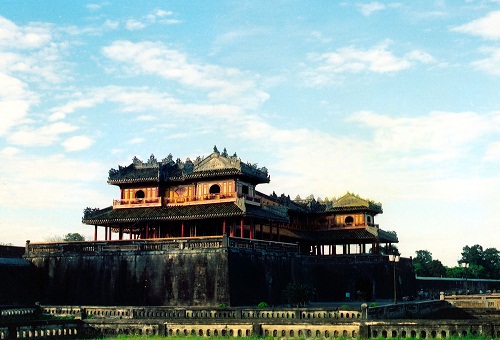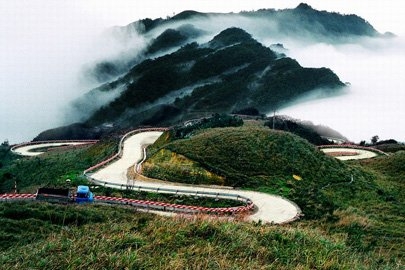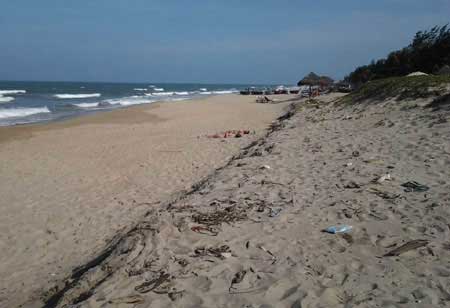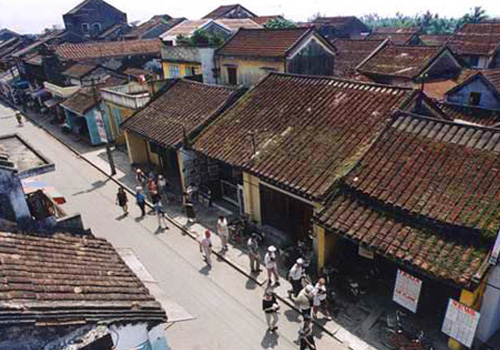It's a nod to us Kiwi patrons from the Irishman behind the bar. But a holiday should not be about hearking for home. And in Vietnam, I discovered, a beer tastes much better when you're perched on a plastic chair - preferably those designed for kids - tipping forward on an uneven pavement and sucking in scooter fumes between sips.
Joining an Intrepid Travel group on a Vietnam Experience, I became one of an increasing number of New Zealanders visiting this fascinating country each year.
Vietnam is Intrepid's top destination, with around 1500 New Zealanders taking a tour each year. Overall visits by Kiwi travellers have doubled from 3365 in 2002 to 6730 people last year, according to Statistics New Zealand.
Friends who had travelled to Vietnam with Intrepid were jealous when I told them I was joining a tour of Herald subscribers. They spoke wistfully of motorbike rides through the countryside, Vietnamese cooking classes and cold beers by the pool after exhausting hours of shopping.
I wasn't sure what to expect from this country - the fastest growing in Southeast Asia - but I was hooked on day one in Ho Chi Minh City.
Sitting on rickety chairs on the footpath with a $1 beer I was watching what seemed to be a fair size portion of the 6.5 million population buzzing past on scooters.
I wanted to be out in that mad traffic trying to make sense of the organised chaos at roundabouts, where motorbikes jostle for space against each other, trucks, buses, cyclos and bicycles.
My photographic evidence for friends shows 30 scooters in line - and three times as many deep - waiting at the lights at a roundabout.
When the lights change the scene is like a wave breaking across the tarseal. The rules are incomprehensible ... and they didn't get any clearer later when I was sitting among it all on the back of a motorbike.
The basic tactics are: give way to anything bigger than you, beep continuously to let everyone know you're coming, and find a gap in the traffic and jostle through.
There's good reason why speeds don't get above 50km/h, especially when you have Mum, Dad and the two kids riding on one scooter. Or if you're transporting kegs of beer strapped on the side. The Vietnamese attitude seems to be: if you can get it on the bike - whether it be cages of animals, construction material or baskets of fruit - you can ride with it.
One especially impressive feat of transportation physics, a bicycle piled high with bicycles, was part of the entertainment on the drive to the Cu Chi Tunnels, 70km north west of the city.
The digging of this vast system of defence tunnels started in 1948 and was successively inhabited by fighters hiding from French and then American forces. By 1965 they stretched at least 200km but the full extent of the tunnels is unknown.
Within the three layers were sleeping, cooking and medical areas, accessed by regular trapdoors throughout the bush. I wasn't game to try squeezing my western hips through the narrow hole but did take an opportunity to briefly experience what it's like to seek shelter underground, by crawling 20 to 30m through a top layer of tunnel.
It was only a short distance to crawl but a few metres in I wanted to go back, and I would have if there had been enough space to turn, but the manoeuvre is impossible.
In stifling heat - it was over 30 degrees above ground and felt 10 times hotter down there - I kept my wits thanks to an American couple in front. She was freaking out as much as me, and he was guiding her forward reassuringly. I could follow their voices but their butts were blocking the lights.
There were many traces of war, from the old army AK47 I used to shoot at a range by the Cu Chi Tunnels, to a massive tank sitting in the forest, looking almost out of place surrounded by sweltering tourists. Elsewhere in the country, we saw boats with hulls made from the scrap of fighter planes, and American hangars still lined the runway at airports where our domestic flights landed.
You could spend months exploring the country but the next best option is a tour, which took our group from Ho Chi Minh in the south to the capital of Hanoi, then north to Halong Bay.
With the help of our local leader Bon and a well-organised itinerary, I slowly stitched together the rich and complex history of Vietnam as we moved through the country.
With pre-dynastic, dynastic, French colonial periods, plus internal war and American war, there is too much to learn in one hit.
But by the time I got to the Museum of Ethnology in Hanoi all the historical pieces were falling into place. Our pace of travel was busy but not hectic and the mix of museums/temples/beaches/shopping and food in good proportion.
A lightning storm lit up the sky and Vietnam wowed me all over again.The perfect antidote to the hustle and bustle of Ho Chi Minh City is Nha Trang, where restaurants and bars line a heavenly white-sand beach and hotels dominate the main drag.
Preparations were under way for a local sea festival and locals were putting together magnificent floats.
The five-star Vinpearl dominates the landscape on the drive from the airport. An ostentatious Hollywood-style sign is plastered across the island off the coast and accessed by cablecar.
We head to a fishing village where young boys play draughts and families on their front porches take little interest in the foreigners wanting a glimpse of their daily lives.
Intrepid promises a real taste of the country and this was one of the many experiences to deliver on the deal. We were taken from our boat by locals in traditional round boats and rowed to the island, where a local guide showed us around.
The day was whiled away with a swim off the boat, seafood smorgasbord and lounging around a small beach purchasing massages and pedicures.
There was more of Vietnam's spectacular coastline to see when we ventured north, flying into Da Nang.
We skirted the city and followed the famous China Beach towards Hoi An. The beach stretches for tens of kilometres into the distance, but judging by the rows of hotel resorts under construction, the views will be harder to glimpse for future travellers.
Inland a few kilometres on is Hoi An, a must-visit town and world heritage site. In keeping with its history as a prosperous trading port and hub of commerce, Hoi An is the place to shop. Tailors shops entice travellers with signs proclaiming their workmanship is the "best in town" according to a guide book or satisfied customers like John and Janet from South Australia.
You could spend days visiting stores, comparing fabric and negotiating prices so, once again, the advantage of a tour comes to the fore, with our New Zealand leader Alison advising us on a shop she has used.
In 30 degree-plus heat it literally takes the sweat out of shopping for clothes. Within an hour I had chosen the material, had my measurements taken and described the coat I had planned in my head.
Back in the shop for a fitting seven hours later, the items were near completion. The following morning they were done and it was like the shop assistant had read my mind. The coat was exactly as I wanted. I was so thrilled I didn't realise until I got home that the button holes had not been cut.
Hoi An's eclectic history of Chinese, Japanese and Western cultures is preserved in the architecture of homes, the temples, pagodas and features like the covered Japanese Bridge. The history is best absorbed in a walking tour with a local guide.
The other ingredient that makes the town a perfect spot is a busy local market, where early risers in our group hit the fish market at 5.30am. I wasn't among them, but a late-night walk through the market offered its own experience of wondering what was scurrying under the tarpaulins covering vegetable stands.
Once the clothes are ordered and the history absorbed, the beautiful beach is just a short bus ride or scooter hire away.
It was almost sunset at the beach when we arrived. Four of us had ventured out on scooters for a ride into the countryside, winding through tight lanes dividing paddy fields. Women could be spotted bent over working with only their conical hats visible above maize, and a bare-chested man ploughed with a water buffalo.
Down at the beach dozens of silhouettes splashed in the tepid water. Riding back I thought it couldn't get much better than this, the last light of the day soaking the rice paddies and river. Then a lightning storm lit up the sky and Vietnam wowed me all over again.
From Da Nang, the drive to the ancient imperial city of Hue city takes you over the Hai Van Pass. There is a faster route through a mountain tunnel but the pass offers spectacular views of the mountains and sandy bays dotting the coast of the South China Sea.
Hue was the seat of power for the Nguyen Dynasty (1802-1945), and the city is dominated by the Citadel, encased by a 10km-long wall. Within it lies the Imperial City, and within that the Forbidden City.
There is lasting evidence of the 1968 Tet Offensive, in which the Viet Cong held the citadel against the Americans. Bullet marks scar the walls and holes have been blasted through the stone by bombs. There is also lasting evidence of imperial grandness with intricate palaces, watch tower, temples and gardens.
Again, I welcomed a guided tour for the opportunity to wander around marvelling at the buildings and moats swelling with lotus plants, while tuning in to the history as I felt the need.
As in Ho Chi Minh and Nha Trang, we used cyclos to get around and familiarise ourselves with the city.
They are a great way to take in surroundings, moving at just the right pace to pull out the camera or jot down the name and address of a shop that looks good to visit later.
Hue was gorgeous at night, with the city's lighting creating a vibrant atmosphere. Cycling past the Citadel, people were gathered under the flag tower lit up by floodlight: families, young couples snuggling on scooters, teenage boys playing with soccer balls. As the cyclos took us over one of two bridges crossing the Perfume River the other was lit up in a changing display of red, purple, green and white.
The Reunification Express took us overnight to Hanoi, 1730km from our starting point 10 days earlier and startling in contrast to that bustling city. The temperature was slightly cooler and the pace more laid back. On our way into the city at 5.30am, hundreds of people were out exercising around the lake. I guessed the jogging, tai chi and badminton going on had something to do with Government instructions to exercise but I was too tired to ask. My assumption was based on an announcement that blasted through public speakers during our visit to Hoi An. The voice, I was told, was telling people to educate their children, vaccinate their pets and giving other friendly reminders.
Bon, our guide, was looking forward to showing us Hanoi, his beautiful home city. We weren't disappointed. The French architecture and tree-lined streets give Hanoi an air of quaintness even though the streets are still full of bikes and cycles and despite a population of 3.5 million. Our base in the Old Quarter was an easy stroll to Ho Hoan Kiem, a picturesque lake in the heart of the city.
Our destinations in the capital included the mausoleum of Ho Chi Minh, where we tourists were pushed to the front of hundreds of people queued up to visit. The mood inside the tomb is sombre and stern soldiers shush anyone who dares even whisper to their companion as people file two by two past the embalmed body.
The atmosphere is more relaxed and pleasant wandering the park-like grounds of the presidential palace, which Ho Chi Minh ditched for more modest surrounds in the form of his Green House, a wooden structure on stilts overlooking a tranquil pond.
A stay in Hanoi is not complete without a visit to a water puppet theatre and our cyclos delivered us just in time. Sensing the downpour was coming, our riders cut short the city tour and cycled fast towards the theatre. Their timing was impeccable as the torrential downpour hit as we walked into the theatre.
The show of more than a dozen short stories reflecting Vietnamese culture, customs and history was an entertaining display of the art form, where wooden puppets are manoeuvred around a thigh-deep pool of water.
The theatre was counted among the highlights of our tour group as we compiled a list on the drive towards Halong Bay. We had seen and experienced so much that a suggestion from one person would prompt memories of what we had done just a week earlier.
Our final adventure was an overnight boat journey around the magnificent bay, a world heritage site that comprises 4000sq km with over 1600 limestone islands, stretching to the China's southern border.
It's a magical location - the strange rock formations and junks with sails set up (for photo purposes rather than any practical reason) - and has some of the most breathtaking scenery I've ever encountered.
In the late afternoon, Bon and I went on a kayaking excursion across to one of the islands and entered its lagoon through a hole in the rock.
Bobbing in the water at the base of sheer cliffs we watched wild monkeys feeding in the trees. As they cheekily dropped their scraps into the water next to us I reckoned I had found another highlight.
| 










-fdc65/mot-ngay-kham-pha-cho-phien-bac-ha.jpg)



